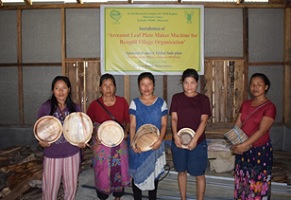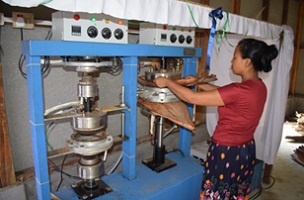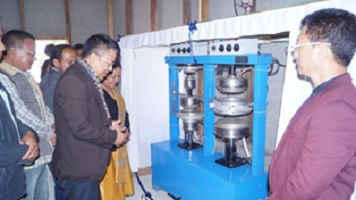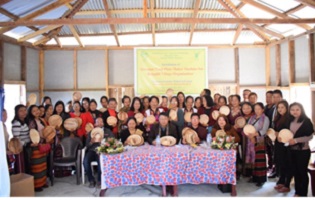In Mizoram, conversion of abandoned jhum areas into settled areca nut (Areca catechu L.; locally known as ‘Kauhva’) plantation have gained popularity and became the most common agricultural practice in Mizoram (particularly, at Kolasib and Mamit district). The average rise in net acreage under areca nut plantation increased by ~23.5% (per annum) over past two decades due to high internal market demand, limited post-harvest processingrequirement and huge export potential to the neighboring state of Assam. The less bio-degradable areca palm sheath are often used as fuel in Mizo household. The conversion of these left-over areca palm leaf sheath into usable products like plate has immense potential to ensure eco-friendly alternative to modern day plastics/polymer plates being used to serve foods in hotel/restaurants/festivals etc., facilitating agro-waste recycling and providing additional source of income to the resource poor tribal farmers of Mizoram.
In order to utilize the readily available raw material (areca palm leaf sheath) coupled with increasing demand for biodegradable ecofriendly areca palm leaf plates, ICAR Research complex for NEH Region, Mizoram center installed two units of semi-automatic motor operated (1.0 HP) areca palm leaf plate maker at Kawnpui Kolasib (24.02'30"N 92.40'22"E&984.5 m ASL)and Rengdil, Mamit (24° 4' 12" N, 92° 22' 48" E &345.8 m ASL) district under Tribal Sub Plan (TSP).


In February 2019, two self-help groups were formed viz. Kawnpui Women Farmers’ Club (43 members) and Rengdil Village Organization (182 members; under Mizoram State Rural Livelihood Mission-Zawlnuam) to facilitate community based skill development on ecofriendly leaf production from fallen areca palm leaf sheaths. Each of the beneficiaries deposit a nominal fee in their common bank account, to meet up the operational expenses (labour, raw material, packing material, electricity charge/ fuel cost, maintenance cost etc.).


The women beneficiaries collect the freshly fallen areca palm leaf sheaths (5 to 8 units of areca palm sheaths plant-1 year-1); and after collection these are sorted and graded. Leaf sheaths which are having in-appropriate size, rotten or damaged are discarded, resulting net average availability of quality raw materials to the tune of 4 to 5 numbers of areca palm leaf sheaths plant-1 year-1. Sun-drying (at least`1 week) is essential before storage of selected areca palm leaf sheaths. Finally, these are converted to the final products (plates) using plate maker machinewith desirable die sizes of 20 cm and 30 cm diameter.The market demand for 30 cm diameter plates is relatively higher as compared to 20 cm diameter plates. Therefore, the women beneficiaries utilized 60% of their collected raw material for making 30 cm diameter plates and the remaining 40% of the raw material was utilized for making 20 cm diameter plates over past three years (Table 1).
Table 1: Availability of raw material and quantity of finished product manufactured in the targeted villages of Mizoram during 2019-20 to 2021-22|
Details of farmers’ group |
No. of usable leaf sheath year-1 |
Total plates manufactured | ||||
|---|---|---|---|---|---|---|
| 2019-20 | 2020-21 | 2021-22 | 2019-20 | 2020-21 | 2021-22 | |
| Kawnpui Women
Farmers’ Club |
101304 | 115233 | 129163 | 182691 | 193980 | 193982 |
| Rengdil Village
Organization |
183974 | 209271 | 226116 | 309161 | 355372 | 382106 |
| Details of farmers’ group | Average no. of plate produced year-1 | Cost of production (Rs. annum-1) | Gross returns (Rs annum-1) | |||
|---|---|---|---|---|---|---|
| 20 cm | 30 cm | 20 cm | 30 cm | 20 cm | 30 cm | |
| Kawnpui Women Farmers’ Club | 92726 | 97491 | 181205 | 225685 | 509993 | 731185 |
| Rengdil Village Organization | 165868 | 183012 | 197295 | 245630 | 912275 | 1372586 |
| Details of farmers’ group | Net returns (Rs annum-1) | B: C ratio | Employment generation (man days) | |||
| 20 cm | 30 cm | 20 cm | 30 cm | 20 cm | 30 cm | |
| Kawnpui Women Farmers’ Club | 328788 | 505500 | 1.81 | 2.24 | 865 | 1330 |
| Rengdil Village Organization | 714980 | 1126956 | 3.62 | 4.59 | 1882 | 2966 |
Impact: Cumulative production of plates by Kawnpui Women Farmers Club and Rengdil Village Organization was about 570653 and 1046639 numbers over past three years, respectively. After three years, Rengdil Village Organization achieved maximum benefits in terms of profitability and employment generation than Kawnpui Women Farmers’ Club(Table 2). The intervention have significant impact on women empowerment besides contributing environmental benefits due to conversion of agro-wastes into an ecofriendly product. The income of beneficiaries to the tune of about 24.97%, as compared to that of non-beneficiaries. Thus, women empowerment initiative under‘Waste to Wealth’ initiativeof TSP programme gained substantial popularity among the tribal households of respective areas and ensured significant improvement in the rural tribal women livelihood in Mizoram.The intervention has emerged as a landmark step towards achieving women empowerment of North East India.
(Source: ICAR NEH Sikkim Center, Mizoram Center, Kolasib Mizoram and Mizoram State Rural Livelihood Mission-Zawlnuam, Govt. of Mizoram)








Like on Facebook
Subscribe on Youtube
Follow on X X
Like on instagram